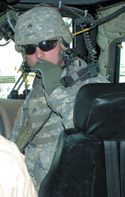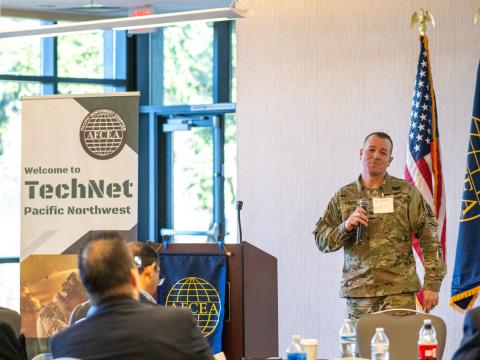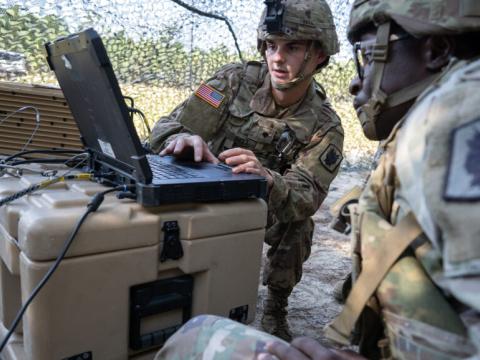Army Communicators Tweak the Network
 |
| Soldiers with the 4th Stryker Brigade, 2nd Infantry Division, radio other friendly forces during a search mission in Iraq. Experiences gleaned in Iraq and Afghanistan are changing the road map for U.S. Army communications. |
Technology innovations and lessons learned in
The Army is viewing the network as a multilevel entity that is adding more varied requirements and challenges as its number of users grows. Issues such as security and information overload are magnified as the complexity of capabilities and requirements increases.
The battlefield is honing the technological edge of the networked Army. Long-term programs offering revolutionary enhancements to network-centric operations are being incorporated early through incremental deployment. These deployments in turn promise to change their parent programs as soldiers apply their new technologies to the harsh combat environment of
“The network capability that the Army has provided to soldiers is benefiting them every day in terms of their ability to operate in a combat environment, their ability to understand and to have improved situational awareness,” says Maj. Gen. (P) Jeffrey A. Sorenson,
The G-6 office has been developing a new 500-day plan to follow in the footsteps of predecessors. This effort began under Lt. Gen. Steven Boutelle,
Gen. Sorenson believes that the best way to implement this plan is to divide it into deliverable increments. The 500-day plan would be parsed into five 100-day rolling plans. So, implementers would be dealing with roughly quarterly goals that provide measurable expectations of what will take place.
The general emphasizes that this approach would not subdivide the 500-day plan into five separate plans. The aim is to establish benchmarks for goals and objectives so that what had been an acquisition plan enters more of a program management realm. Each of the plan’s six strategic goals would remain intact, but the objectives of those goals would be broken down into increments.
Gen. Sorenson states that the biggest challenge for the Army in meeting its information technology needs involves delivering the network. People must recognize that the network has different levels: standards, which define how data will be transferred among databases; enterprise services; the transport layer that provides the communications pipeline; software applications; and sensors that gather data and feed it into the network for advanced situational awareness. Slicing the network into these layers is a way of parsing that network to deliver it effectively, the general states.
Gen. Sorenson continues that the Army is doing very well delivering the network at the transport level. This encompasses the newly combined Joint Network Node (JNN) and Warfighter Information Network–Tactical (WIN-T), among others.
However, future challenges loom, particularly at the standards level, he warns. The number of different databases has grown to the point where nearly each staff element maintains its own database. The Army must attempt to scrub these databases, the general says, to provide a better structure so that decision-making areas have single databases. The same approach will be applied at the tactical level, where the same proliferation exists.
For services, the Army has about 1,700 systems, many of which are redundant, that must be examined for relevance and importance. The Army cannot continue to support all of these systems, most of which were developed in stovepipes, the general maintains.
In the software applications realm, new applications are being delivered to improve network use, and personnel will need to adjust to them. New types of sensors also are being delivered, and they promise capability improvement in orders of magnitude. This in turn will require changes to accommodate the new amounts and types of data these sensors will generate.
Getting that sensor information down to the individual warfighter will be an increasing challenge, Gen. Sorenson predicts. The Army is relying largely on commercial technology for many network aspects, and low bandwidth is a problem for many soldiers. When these new sensors begin feeding their information into the network, its bandwidth requirements will become more complicated as more users send more information. Planners will need to determine which information is required at the lowest level and how and where to allocate bandwidth. Network managers with brigade combat teams will find their jobs more and more challenging, the general offers.
The Army already has gleaned important expertise as it strives to move information down to the individual warfighter in
So when Land Warrior was deployed to some units in
Gen. Sorenson observes that the Future Combat Systems (FCS) program will radically change the way the Army operates in the field, particularly because it is being built as an integrated system from the ground up. He notes that Army Battle Command System (ABCS) elements were developed over many years as stovepipe systems, and they were left to the warfighter to make them work in the field. As FCS systems begin deployment, the warfighters’ network will function differently.
He explains that ABCS essentially has a tactical operations center (TOC)-centric capability running from divisions to brigades to battalions. But, when FCS begins to take hold, it will flatten that network. Much of its information will be available on a distributed basis. “That will entail a radical change in the way we function as an army—changes in doctrine, in training, in the way we will be able to fight,” he emphasizes. The Army will go through “a passage of lines” from the TOC-centric capability to a flattened capability.
The dilemma will be in how to synchronize the incremental changes that will come with FCS incorporation. New capabilities will need to be backward-compatible so they can interoperate with legacy systems, whether information systems or combat systems.
The general declares that the worst damage that could be inflicted on FCS would be if officials slowed the development of its network capability—the System-of-Systems Common Operating Environment, or SOSCOE. Many experts within military and industry are working on SOSCOE, which will serve as the foundation of future Army battle command systems. The Army is using SOSCOE to form a basis for the Defense Department’s joint Net-Enabled Command Capability, or NECC, he says.
Supplemental funding has been an essential part of the Army fielding its best systems to its warfighters. Gen. Sorenson offers that the Army will continue to count on supplemental funding to accelerate the delivery of vital capabilities. He adds that the Army has been prudent in its planning for budgets that would provide the necessary resources for delivering network centricity to warfighters.
Supplemental funding has accelerated deployment of many capabilities, such as JNN. The Army has funded in its program objective memorandum (POM) JNN delivery through 2013. Supplemental funding has enabled the Army to accelerate JNN deployment. But the general emphasizes that even if supplemental funding dries up, the Army still will be able to deploy JNN through POM processes, albeit at a slower rate.
“We’re doing our best to do judicious planning for the future,” he declares. “On the other hand, we’re trying to use supplemental funding to accelerate that [JNN] capability because it’s required now.”
 |
| A satellite communications technician with the 1st Brigade Special Troops Battalion communicates with other team members during a search for improvised explosive devices in Iraq. As Army network operations expand, so do the challenges of maintaining security and ensuring that forces have the latest technologies. |
Gen. Sorenson continues that JNN is “absolutely critical,” for soldiers in the field. The Army is moving toward an Internet protocol-based force that includes the convergence of voice, data and video. This convergence is necessary for a reach-back capability. The Joint Tactical Radio System (JTRS) effort (SIGNAL Magazine, July 2007) is another important program, the general adds.
Biometric identification is proving its worth in
As the Army’s G-6, the general also is the Army CIO, and this tasking brings with it different challenges. Gen. Sorenson says that one major hurdle is to ensure that the Clinger-Cohen Act requirements are as streamlined as possible during acquisition. Often, a single program manager will undertake all Clinger-Cohen requirements and then report them to the G-6 office. That office should work with program managers on Clinger-Cohen issues early in the program, which will help prevent program implementation being held up at the G-6 level, he states.
The CIO also must address some of the issues that face Army information systems at the enterprise level. The Army must review its 1,700 systems with an eye toward eliminating some to improve efficiency, the general says.
Security remains a concern, however. The Army must continue to defend and protect the network against attack from a host of adversaries. Gen. Sorenson relates that the Army is attempting “scrubs” of its network by analyzing its content and its use. He notes that in many cases, users have systems on the network for which they have no licenses or do not even use. The Army has been experimenting in local areas with a commercial application that reviews network applications, their users and their activity. Early indications have been positive, and its use may be expanded.
As connectivity proliferates among users, securing the network will be “extraordinarily more difficult,” Gen. Sorenson states. Hardware items from thumb drives to handheld personal digital assistants to desktop computers must be addressed as network access portals. The challenge goes beyond security lapses to include simple accidents that nonetheless can provide a security breach. The Army must spend time educating all of its soldiers—not just its senior leaders and noncommissioned officers—on how vulnerable the network can be and the consequences of security breaches, the general declares.
Among recent incidents are cases in which intruders have tampered with blogs. A soldier who thought he merely was posting basic identity information found his data changed into propaganda that was noted on a terrorist Web site, the general reports. Soldiers must be educated as to these diverse types of threats.
“It’s going to continue to be ‘Spy versus Spy,’” Gen. Sorenson declares. “This is going to be a continual battle of securing and eliminating vulnerabilities on the network. And, it is going to become more complicated as we continue to roll out and develop FCS.”
Biometric security needs dominate the long-term picture. As the Army continues to develop its network at the tactical level, it will need biometric solutions. The Army currently uses common access card (CAC) security for requirements, but that solution does not always suit combat conditions. A soldier who loses a CAC in combat effectively is shut out of any computer or network access.
The necessary security interface—in which a logon details who is online, what authorities that user has and the person’s delegations—must be seamless to the user. A biometric capability offers the best path to providing effective security for both the user and the network, the general says. And, the Army will need secure wireless technologies at the classified level to move vital information throughout the battlespace.
Meeting many of the Army’s information technology challenges will require integrated solutions from industry, the general emphasizes. “We don’t need any independent, proprietary types of solutions that—though they might be useful and effective—in the long term don’t benefit us.”
The Army is working with industry to communicate its requirements better. The general cites as an example how the Army is working with Microsoft as the largest user of its products. The service has worked with the software giant early in the product development phase to insert Army requirements into software designs. The Army also is involved with other high-technology companies to influence product design. These steps are necessary both for ensuring that commercial products serve Army needs and for speeding new technologies into the force.
“The difficulty is in trying to continue delivering improved capabilities,” the general elaborates. “If kids today don’t like a cell phone, they just go buy a new one. But to try to do that over the entire Army in a flash just doesn’t happen. So, it is the continual challenge of evolving technology, staying abreast of technology, trying to deliver the newest types of capabilities—but doing it in a manner so that you are not breaking the system.
“To date, we have been very successful,” he continues. “Some would say we haven’t done it quickly enough, but on the other hand I think that everything we have delivered has worked.”
Web Resources
Future Combat Systems: www.army.mil/fcs
Joint Tactical Radio System: http://enterprise.spawar.navy.mil/body.cfm?type=c&category=27&subcat=60
Joint Network Node: http://peoc3t.monmouth.army.mil/trcs/jnn.html
Warfighter Information Network–Tactical: http://peoc3t.monmouth.army.mil/win_t/win_t.html




Comments